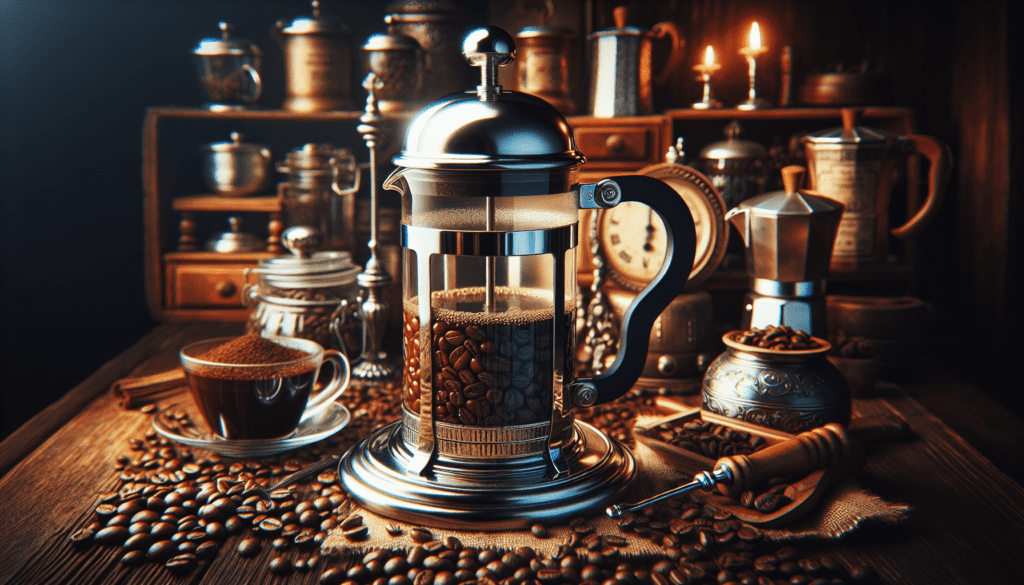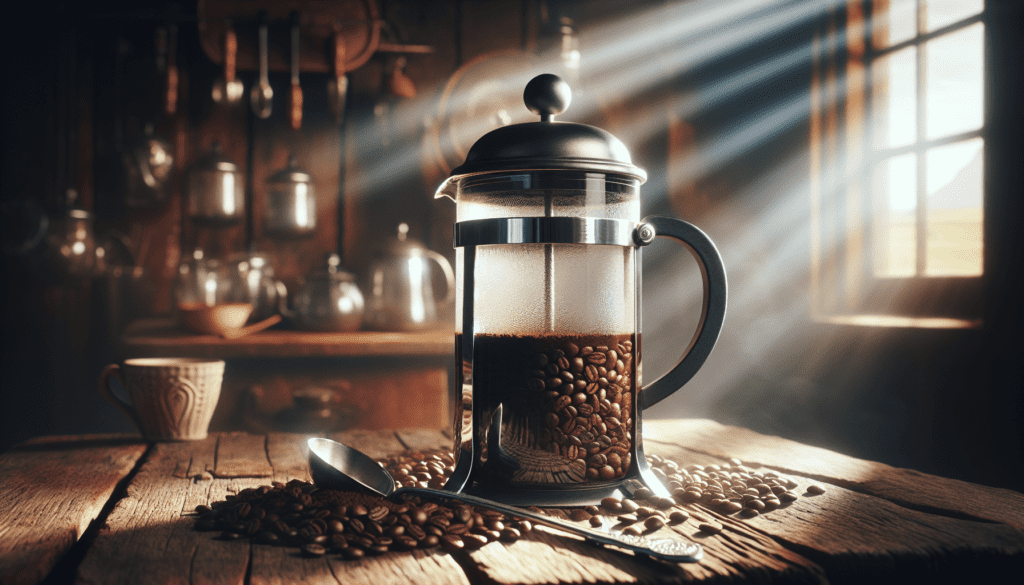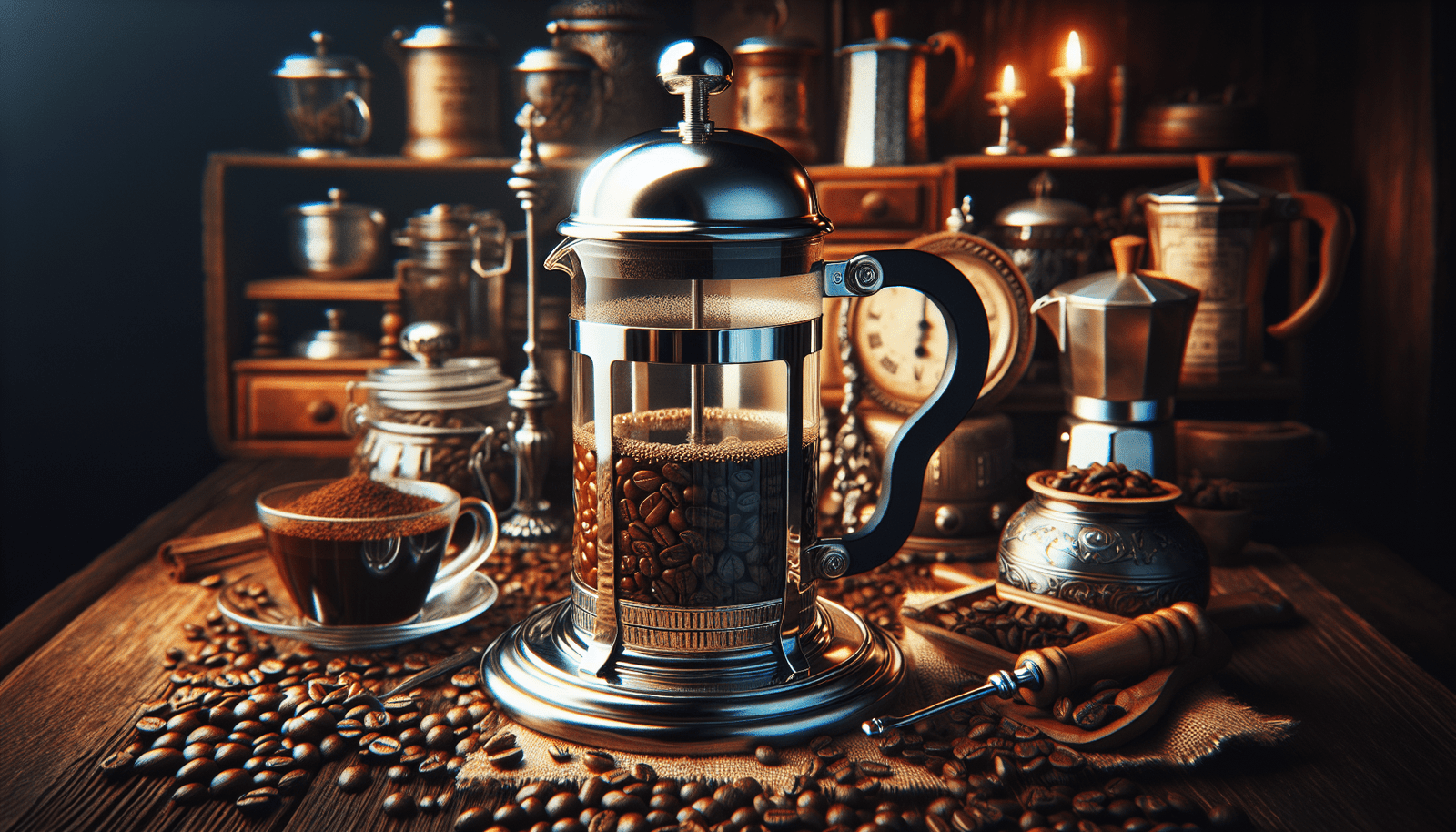If you’re a coffee lover, then you know that the type of coffee beans you use can greatly impact the taste and overall experience of your brew. Whether you prefer a strong, bold flavor or a smooth, mellow cup of coffee, finding the best coffee beans for your French press is essential. In this article, we’ll take you on a journey through the world of coffee beans, exploring the different origins, flavors, and brewing methods. From discussing the nuances of espresso beans vs. coffee beans to the intriguing concept of civet coffee, we’ll cover it all. So sit back, grab your French press, and get ready to discover the best coffee beans to elevate your daily cup of joe.

1. Understanding French Press
What is a French Press?
A French Press, also known as a press pot or plunger pot, is a brewing device used to make coffee. It consists of a glass or stainless steel cylindrical beaker with a tightly fitting plunger and a metal mesh filter. The simplicity of its design allows for easy use and maintenance.
How Does a French Press Work?
To brew coffee using a French Press, the user places coarsely ground coffee into the empty beaker, adds hot water, and then inserts the plunger with the filter attached. After allowing the coffee to steep for a few minutes, the plunger is slowly pressed down, separating the grounds from the brewed coffee. The metal mesh filter ensures that no coffee grounds end up in the final cup.
Advantages of Using a French Press
Using a French Press offers several advantages for coffee enthusiasts. One key advantage is the control it provides over the brewing process. The user can determine the water temperature, steeping time, and even the pressure applied while pressing down the plunger. This allows for customization and experimentation to achieve the desired flavor and strength of the coffee.
Another advantage is the full-bodied and robust flavor that a French Press produces. The metal mesh filter allows more coffee oils and sediments to pass through, resulting in a rich and flavorful cup of coffee. Additionally, a French Press is a versatile brewing method that can be used to make both hot and cold brews, providing flexibility for different preferences and seasons.
2. Factors to Consider when Choosing Coffee Beans for French Press
Roast Level
When selecting coffee beans for French Press brewing, the roast level is an important factor to consider. The roast level can significantly impact the flavor profile and intensity of the coffee. For a French Press, medium-dark to dark roasts are recommended as they tend to have bolder flavors that can withstand the immersion brewing process.
Bean Origin
The origin of the coffee beans also plays a crucial role in the taste experience. Different regions produce coffee beans with distinct flavor notes and characteristics. Some popular origins for French Press coffee include Colombian, Brazilian, Ethiopian, Costa Rican, and Sumatran beans.
Bean Variety
The variety of the coffee bean, such as Arabica or Robusta, influences the taste and aroma of the brewed coffee. Arabica beans are known for their nuanced flavors and pleasant acidity, making them a popular choice for French Press brewing. Robusta beans, on the other hand, are bolder and have a higher caffeine content, making them suitable for those who prefer a stronger cup of coffee.
Freshness
The freshness of the coffee beans is crucial for achieving the best flavor in French Press brewing. Opting for freshly roasted beans ensures that the flavors and aromas are at their peak. Look for coffee beans with a roast date on the packaging and try to use them within a few weeks of roasting.
Ground Size
For French Press brewing, a coarse grind size is essential. The larger particles allow for a slower extraction process and prevent the coffee from becoming too bitter. Avoid using finely ground coffee meant for espresso or drip brewing methods, as it can lead to over-extraction and a muddy cup.
3. Recommended Roast Levels for French Press
Medium-Dark Roast
A medium-dark roast is a popular choice for French Press brewing due to its balance between flavor and strength. It offers a slightly more pronounced caramelization of sugars within the beans, resulting in a rich and full-bodied cup. The medium-dark roast brings out the sweetness and complexity of the coffee without sacrificing too much of the bean’s inherent flavors.
Dark Roast
For those who enjoy a bold and intense cup of coffee, a dark roast is an ideal option. Dark roasts are known for their smoky, chocolaty, and sometimes nutty flavors. The extended roasting process gives the beans a deep and robust taste that pairs well with the immersion brewing method of a French Press.
4. Best Coffee Bean Origins for French Press
Colombian Coffee Beans
Colombian coffee beans are known for their well-balanced flavors and pleasant acidity. They often have notes of caramel, chocolate, and citrus, making them an excellent choice for French Press brewing. Colombian beans are widely available and can be enjoyed by coffee enthusiasts of all levels.
Brazilian Coffee Beans
Brazil is one of the largest coffee producers in the world, and its beans are cherished for their low acidity and nutty sweetness. Brazilian coffee beans are often used in blends for their smooth and mild characteristics. When brewed with a French Press, they deliver a satisfying and flavorful cup of coffee.
Ethiopian Coffee Beans
Ethiopian coffee beans are highly regarded for their distinct and complex flavors. They offer a wide range of tasting notes, from fruity and floral to earthy and wine-like. French Press brewing allows these flavors to shine, resulting in a unique and vibrant coffee experience.
Costa Rican Coffee Beans
Costa Rican coffee beans are known for their bright acidity and clean flavors. They often exhibit fruity and citrusy notes, along with a honey-like sweetness. These characteristics make them a delightful choice for French Press brewing, particularly for those who enjoy a well-balanced and refreshing cup of coffee.
Sumatran Coffee Beans
Sumatran coffee beans originate from the western part of Indonesia and are renowned for their full-bodied and earthy flavors. They often have notes of tobacco, dark chocolate, and spices, which can create a rich and complex cup of coffee when brewed using a French Press. Sumatran beans are beloved by those who prefer a bold and robust flavor profile.

5. Popular Bean Varieties for French Press
Arabica Coffee Beans
Arabica coffee beans are the most widely consumed coffee variety globally. They are known for their nuanced flavors, ranging from fruity and floral to chocolaty and nutty. Arabica beans have lower caffeine content compared to Robusta beans, but they provide a more complex and enjoyable flavor experience when brewed using a French Press.
Robusta Coffee Beans
Robusta coffee beans have a higher caffeine content and a more pronounced bitter taste compared to Arabica beans. This makes them suitable for those who prefer a stronger and more robust cup of coffee. Robusta beans are often used in blends to add depth and intensity to the final brew when using a French Press.
6. Importance of Freshness in French Press
Why Freshness Matters
Freshness is vital in French Press brewing because it allows for the extraction of the most vibrant and aromatic flavors from the coffee beans. As coffee beans age, they lose their natural oils and flavors, resulting in a dull and flat-tasting brew. Using fresh coffee beans ensures that you get the full spectrum of flavors and aromas in your cup of French Press coffee.
How to Identify Fresh Coffee Beans
To identify fresh coffee beans, look for a roast date on the packaging. Ideally, choose beans that have been roasted within the past two weeks. Avoid coffee beans that do not have a roast date or have a date that is too far in the past. Additionally, the beans should have a strong and pleasant aroma, indicating that the oils and aromatics are still intact.
Storing Coffee Beans Properly
To maintain the freshness of your coffee beans, it is essential to store them properly. Keep them in an airtight container away from light, heat, and moisture. Avoid storing them in the refrigerator or freezer, as exposure to fluctuating temperatures can negatively affect the flavors. It is best to purchase coffee beans in small quantities to ensure that you can consume them within a few weeks of the roast date.
7. Grinding Coffee Beans for French Press
Coarse Grind Size
For French Press brewing, a coarse grind size is necessary to prevent over-extraction and a gritty mouthfeel. The larger particles allow for a slower extraction process, resulting in a well-rounded and smooth cup of coffee. Investing in a quality burr grinder with adjustable settings can help achieve the desired coarse grind consistency.
Burr Grinder vs. Blade Grinder
When grinding coffee beans for French Press, it is recommended to use a burr grinder rather than a blade grinder. Burr grinders offer more precise and consistent grind sizes, which is crucial for achieving a balanced extraction. Blade grinders, on the other hand, can produce uneven particle sizes, leading to over-extraction or under-extraction of the coffee grounds.
Tips for Consistent Grind Size
To ensure a consistent grind size for French Press brewing, here are a few tips:
- Adjust the grind size according to personal preference. If the coffee tastes too weak or watery, try a slightly finer grind; if it tastes too bitter or over-extracted, go coarser.
- Use a scale to measure the coffee beans before grinding. This helps maintain consistency in the coffee-to-water ratio.
- Grind the coffee beans just before brewing to preserve freshness and minimize flavor loss.
- Experiment with different grind sizes to find the optimal one for your taste preferences and brewing method.
8. Recommended Coffee Beans for French Press
Blue Bottle Coffee – Three Africas Blend
Blue Bottle Coffee offers a unique blend called Three Africas that is specifically designed for French Press brewing. It combines beans from Ethiopia, Uganda, and Rwanda to create a medley of flavors, including bright citrus, floral tones, and a hint of sweetness. The Three Africas Blend produces a well-balanced and vibrant cup of coffee that is perfect for French Press enthusiasts.
Intelligentsia Coffee – Black Cat Classic Espresso
Although marketed as an espresso blend, Intelligentsia Coffee’s Black Cat Classic Espresso also works exceptionally well for French Press brewing. This blend combines coffees from Latin America and Indonesia to create a rich and full-bodied flavor profile. With notes of chocolate, caramel, and a mild acidity, it delivers a satisfying and robust cup of coffee when brewed with a French Press.
Stumptown Coffee Roasters – Hair Bender
Stumptown Coffee Roasters’ Hair Bender is a blend beloved by coffee enthusiasts worldwide. It consists of beans from Latin America, East Africa, and Indonesia, resulting in a complex and unique flavor profile. When brewed using a French Press, Hair Bender offers a balanced combination of sweetness, acidity, and depth, making it an excellent choice for those seeking a flavorful and nuanced cup of coffee.
Peet’s Coffee – Major Dickason’s Blend
Peet’s Coffee Major Dickason’s Blend is a classic and reliable choice for French Press brewing. This blend features a mix of beans from Central and South America, resulting in a well-rounded and full-bodied flavor. With its dark and rich intensity, Major Dickason’s Blend shines when brewed in a French Press, producing a robust cup of coffee with notes of chocolate and smokiness.
Counter Culture Coffee – Forty Six
Counter Culture Coffee’s Forty Six is a single-origin offering from Ethiopia, renowned for its enticing flavors. With tasting notes of bergamot, cherry, and chocolate, Forty Six delivers a delightful and vibrant coffee experience when brewed using a French Press. Its complexity and brightness make it an excellent choice for those who appreciate the unique characteristics of Ethiopian coffee.
9. Additional Tips for Brewing French Press Coffee
Water Temperature and Brewing Time
For French Press brewing, the ideal water temperature is around 195°F to 205°F (90°C to 96°C). Boil the water and then let it cool for about 30 seconds before pouring it over the coffee grounds. Steep the coffee for about 4 to 5 minutes, adjusting the brewing time to personal taste preferences.
Ratio of Coffee to Water
A common guideline for French Press brewing is to use a ratio of 1 part coffee to 15 parts water. However, feel free to adjust the ratio based on personal preference. If a stronger cup is desired, increase the amount of coffee; for a milder cup, decrease the amount. Use a scale to measure the coffee and water accurately.
Preheating the French Press
Before adding coffee and water, preheat the French Press by rinsing it with hot water. This helps maintain the brewing temperature and ensures an even extraction of flavors.
Avoiding Over-Extraction
To avoid over-extraction, which can result in a bitter and unpleasant taste, it is essential to press the plunger down gently and slowly. Applying too much pressure can lead to the extraction of undesirable flavors from the coffee grounds.
Proper Cleanliness and Maintenance
After each use, clean the French Press thoroughly to remove any leftover coffee grounds and oils. Disassemble the plunger and filter, and rinse all components with warm water. Avoid using soap, as it can leave a residue that affects the taste of future brews. Occasionally, deep clean the French Press by soaking it in a mixture of water and vinegar, then thoroughly rinsing.
10. Experimenting with Different Coffee Beans in French Press
Single-Origin vs. Blended Coffee Beans
French Press brewing provides an excellent opportunity to explore the flavors of both single-origin and blended coffee beans. Single-origin beans highlight the distinct characteristics of a particular region, offering a unique and focused taste experience. Blended coffee beans, on the other hand, combine beans from different origins to create complex and balanced flavor profiles. Experimenting with both types allows for a broad exploration of flavors and aromas.
Flavored Coffee Beans
While flavored coffee beans are more commonly associated with other brewing methods, such as drip or espresso, they can still be used in a French Press. However, it is essential to note that flavored beans can leave residual oils and flavors in the mesh filter, potentially impacting future brews. If using flavored beans in a French Press, thoroughly clean the mesh filter after each use to avoid flavor contamination.
Organic and Fair Trade Options
For those who prioritize sustainability and ethical practices in coffee production, organic and fair trade coffee beans are excellent choices. Organic coffee beans are grown without the use of synthetic pesticides or fertilizers, while fair trade ensures that coffee farmers receive fair prices for their beans. Look for certifications on the packaging to ensure that the beans adhere to these standards.
Decaf Coffee Beans
Decaf coffee beans provide an alternative for those who love the taste of coffee but want to limit their caffeine intake. French Press brewing can bring out the flavors and complexities of decaf beans, resulting in a satisfying cup of coffee that can be enjoyed even in the evening without interfering with sleep. Look for decaf beans that have undergone a Swiss Water Process or CO2 method for a chemical-free decaffeination process.
In conclusion, selecting the best coffee beans for French Press brewing involves considering factors such as roast level, bean origin, bean variety, freshness, and ground size. Medium-dark to dark roast levels are recommended, as they provide the depth and flavor necessary for a robust cup of coffee. Coffee beans from Colombia, Brazil, Ethiopia, Costa Rica, and Sumatra offer unique taste experiences when brewed in a French Press. The choice between Arabica and Robusta beans depends on personal preference for taste and caffeine content. Freshness is crucial, and proper storage helps preserve the flavors of the coffee beans. Using a coarse grind size and investing in a burr grinder contribute to consistent and optimal extraction. Several coffee bean options are highly recommended for French Press brewing, with blends like Blue Bottle Coffee’s Three Africas and Stumptown Coffee Roasters’ Hair Bender, and single-origin options like Counter Culture Coffee’s Forty Six. Additional tips for brewing a perfect French Press coffee include controlling water temperature, adjusting the coffee-to-water ratio, preheating the French Press, avoiding over-extraction, and maintaining cleanliness. Lastly, there is room for experimentation with different coffee bean varieties, flavored beans, organic and fair-trade options, and decaf beans in a French Press. Enjoy the journey of exploring the best coffee beans for your preferred French Press brewing method and savor the rich and flavorful cups that await you.

